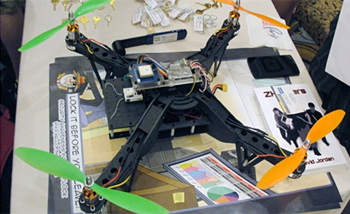INDIAN ARMED FORCES CHIEFS ON
OUR RELENTLESS AND FOCUSED PUBLISHING EFFORTS

SP Guide Publications puts forth a well compiled articulation of issues, pursuits and accomplishments of the Indian Army, over the years

I am confident that SP Guide Publications would continue to inform, inspire and influence.

My compliments to SP Guide Publications for informative and credible reportage on contemporary aerospace issues over the past six decades.
- Prime Minister witnesses 'Bharat Shakti' – a Tri-Services Firing and Manoeuvre Exercise in Pokhran, Rajasthan
- Interim Defence Budget 2024-25 — An Analysis
- Union Defence budget 2024
- Prime Minister Modi Commemorates Indian Navy Day in a Grand Ceremony
- Prime Minister Modi Flies in the LCA Tejas
- New Chapter in India-Italy Defence Ties
- Airpower beyond Boundaries
Hacker-quadcopter – new threats emerging
 |
By Lt. General P.C. Katoch (Retd) Former Director General of Information Systems, Indian Army |

As if the threat of terrorist attacks using drones was not enough, a new threat of hacking and cyber attacks through drones has emerged on the horizon. During the DEF CON 23 hackers conference held from 6-9 August at Las Vegas, US last month a US company called ‘Aerial Assault’ displayed a quadcopter modified as a flying hacker that scans the world below for insecure devices and vulnerable Wifi ports. The firm claims they built the tool for penetration testing to help “good guys” diagnose their own weaknesses but concede that with a bit of modification, it could be used to exploit those vulnerabilities and install malware from the air. This hacker-quadcopter (picture below) can be bought just for US$ 2,500 and can be turned into a malware injector, and reportedly is the first unmanned aerial penetration tool for sale to the public.
Aerial Assault’s hacker-quadcopter uses a small Raspberry PI computer running the Kali Linux penetration tester software with the broadcast range extended by alpha radio antennas. This invention opens up new dimensions for both terrorism and in cyber warfare, as there has never been such capability before. Earlier versions of hacking drones were able to pose as unsecured wireless networks, harvesting data from gullible users. But this Aerial Assault model is the first drone armed with automated hacking tools, the drone loaded with an array of software capable of looking for weaknesses in any unsecured wireless networks in range, recording information about vulnerabilities, and capturing the precise GPS coordinates of the target. Penetration testing was usually being done through the existing networks. However, arming a drone with the software means that hackers can sneak up on networks not intended for communication with the outside world, which are usually less secure. So now hackers would have a new weapon in their arsenal; a drone loaded with software capable of probing any wireless network in range, and relaying the data to its operator.
It may be recalled that in January 2015, a drone crashed on the White House grounds, raising questions about safe use commercial and consumer drones in the US and in April 2015, a drone with traces of radioactive material in a bottle and mounted with a camera was discovered on the roof of Prime Minister Shinzo Abe’s office in Tokyo. A recent study in the US brings home the chilling conclusion that one single disciple of ‘Lone Wolf Terrorism’ is capable of killing millions, which incidentally is being propagated by the ISIS. The New York Police Department (NYPD) has been concerned about potential terror attack from the air through a drone armed with a deadly weapon. India is world’s top drone importer after UK and France. Between 1985 and 2014, 22.5 percent of world’s UAVs were imported by India. Within the country we have multiple manufactures marketing drones, remote controlled toys for children, cam-copters for surveillance and private clubs indulging in drone flying adventure. Drones are being used in the country for shooting concerts, movies, private parties, police organizations for surveillance, NDRF, and for surveillance and intelligence gathering by armed forces.
During Republic Day Parade 2015 with President Barak Obama as Chief Guest, there were warnings that terrorists may attempt drone strikes, even using a glider. Similar warnings were given by intelligence agencies in the past, plus also during 15th August 2015 particularly for New Delhi; groups like the LeT and JeM having planned drone attacks. A terrorist organization could use drones with IR cameras by night and deliver chemical or radioactive payloads. Small drones are much more difficult to detect as they need little space to take off. Link all this to reports of a UAV acquired through a 3D printer that has been successfully flown and more significantly the ISIS having published a hit list of some 1500 US and Australian defence officials, politicians and their families, details of whom were reportedly obtained through hacking. So the hacker-quadcopter can be exploited by: radicals for terrorist acts; criminals, who can hack objects to understand target behavior, steal information, and commit financial crimes, and; governments, who have a new set of devices with which to spy on people. The government needs to seriously look into these threats and how to counter them aside from evolving comprehensive regulations for use of drones. The urgency is much more with more and more terrorism gravitating towards the Sub Continent.





